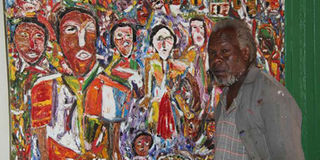Breaking News: At least 10 feared to have drowned in Makueni river
Brush Wanyu: I will paint till my last day on earth

Brush Munyu poses next to one of his paintings. PHOTO | JOHN NGUNJIRI
What you need to know:
- Brush, real name, John Njenga, is among a notable group of pioneering Kenyan artists, a number of whom hail from this famous village. Ngecha is about the only Kenyan village with two functioning commercial art galleries and a huge number of practising visual artists.
- Brush trained in batik print making at the Shauri Moyo YMCA in 1967, but the training, as he says, was not of much value to him. “I could not stand the smell of the wax used in the batik process so I stopped,” he explains.
- He has been practising art for the last 47 years and to mark this milestone, he will be holding a month-long exhibition, starting from June 4, at the Banana Hill Art Gallery, which is owned by another of illustrious visual artist from Ngecha, Shine Tani.
rush Wanyu once had a healthy crop of jet black hair, which he had fashioned into dreadlocks. Today, all that is left of the locks are few strands of white hair, hanging valiantly on the sides and back of his head.
His legs are not what they used to be; arthritis routinely lays ambush on his knees, leaving him practically immobilised during the cold season.
Age has had a toll on the man, now approaching 70, who through paint and brushes, put the sleepy Ngecha Village in Kiambu County, on the world map as far as visual art is concerned.
Brush, real name, John Njenga, is among a notable group of pioneering Kenyan artists, a number of whom hail from this famous village. Ngecha is about the only Kenyan village with two functioning commercial art galleries and a huge number of practising visual artists.
Advancing age and ill-health haven’t stopped Brush from wielding his brushes. Every day he locks himself in his studio, within his one-storied timber and mabati house, sits on a traditional three-legged stool and transfers his creative magic on to canvas. In 2010, his abstract piece titled Never, Never Again, based on the 2007/08 post-election violence, fetched him a cool Sh2 million at an exhibition held at the now defunct Gallery Watatu.
Brush furrows his bearded face in sadness when he talks about the demise of the gallery that moulded his art and catapulted him to fame and made his wallet reasonably healthy.
He speaks fondly of Ruth Schaffner, who run the gallery until her death in 1996. “Life was good when Ruth was around,” Brush recalls nostalgically. “I would take my paintings to the gallery and she would sell them for me. I would collect a cheque for not less than Sh100,000 on a weekly basis without fail.”
Other notable artists in the Gallery Watatu stable, included Ugandan Jak Katarikawe, also ailing, and Sane Wadu, also from Ngecha, but now based in Naivasha, among others.
VISUAL ARTS
After Ruth passed on, her partner, Adama Diawara, an Ivorian, took over the running of the gallery, but it was never quite like Ruth’s time.
The party, or whatever had been left of it, came to a screeching halt after Adama breathed his last in 2011. Spiralling debt, rent arrears and suspected pilferage by staff eventually brought Gallery Watatu, then based at the mezzanine floor of Lonrho House, in downtown Nairobi, to its knees.
Today, what is left of Gallery Watatu – a container full of artwork detained at the Rongai Police Station – has been the subject of a prolonged and bitter court battle featuring supposed beneficiaries of the late Adama’s estate. All claim to be the rightful heirs and thus demand a share of the vast collection of art valued at several hundreds of millions.
That is how Brush and co found themselves deprived of a regular source of income. Without a gallery willing to exhibit his works on a regular basis, Brush relies on the occasional art auction, and they are few and far between in Kenya, or home sales to make ends meet.
Brush trained in batik print making at the Shauri Moyo YMCA in 1967, but the training, as he says, was not of much value to him. “I could not stand the smell of the wax used in the batik process so I stopped,” he explains. Disoriented, he did odd jobs here and there before his love of art pulled him back.
“I taught myself sculpture and painting and when I took my first artworks to Ruth, she wondered where I had been all along as I painted like a veteran,” recalls Brush.
That was the motivation he required; there was no turning back from that point. Brush is a recipient of a Head of State Commendation medal from retired President Mwai Kibaki, for his contribution to the world of art in December 2009.
He has been practising art for the last 47 years and to mark this milestone, he will be holding a month-long exhibition, starting from June 4, at the Banana Hill Art Gallery, which is owned by another of illustrious visual artist from Ngecha, Shine Tani.
“This will be a solo exhibition featuring the journey of my works, the ones still in my possession, from as far back as 1989 to what I have been currently working on,” he explains.
Brush whose eyesight is now failing says he is not about to give up doing what he loves best; painting. “My inner eye, the one responsible for colour is still intact,” he explains. “That one is inborn and will be with me for a long time to come. I am yet to hang up my brushes. I will paint to my last day on earth.”




